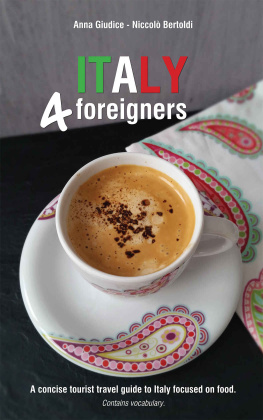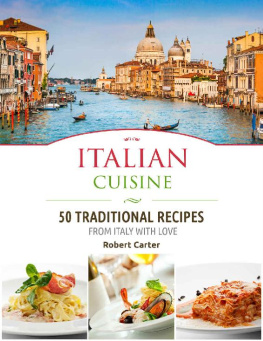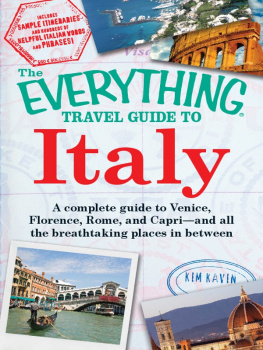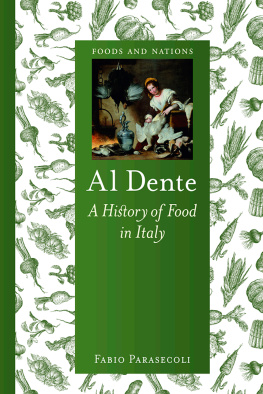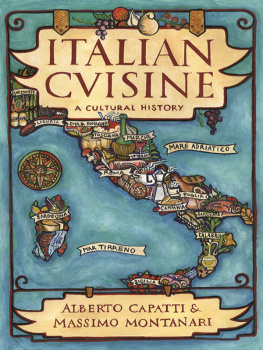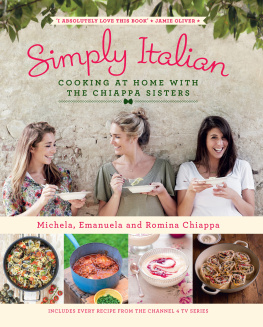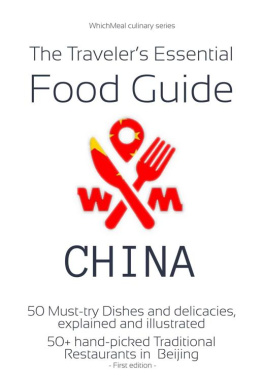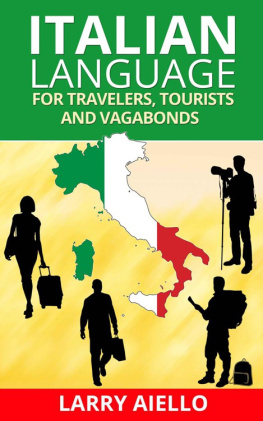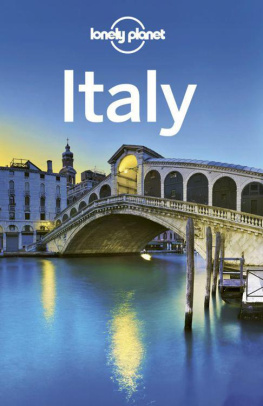Italy4 foreigners
A concise touristtravel guide to Italy focused on food. Contains vocabulary.
Anna Giudice Niccol Bertoldi
Firstdigital edition April 2015
Allrights reserved. No part of this publication may be reproduced, stored in aretrieval system or transmitted in any form by any means, electronic,mechanical, photocopyng, recording or otherwise, without the prior writtenpermission of the copyright holders.
Copyrighttexts and imagesAnna Giudice andNiccol Bertoldi
Contacts:
WHO WE ARE AUTHORS PROFILES
AnnaGiudice ,53, italian, journalist, food blogger. I am passionate of my country and I lovestudying, experimenting, cooking (sometimes) and eating food from all over theworld.
NiccolBertoldi , Ihave been 20 years old for 20 years and still havent decided what I want to dowhen I am grown up. In the meanwhile I love to travel, to eat and to learn newlanguages. All the English mistakes in this book are mine.
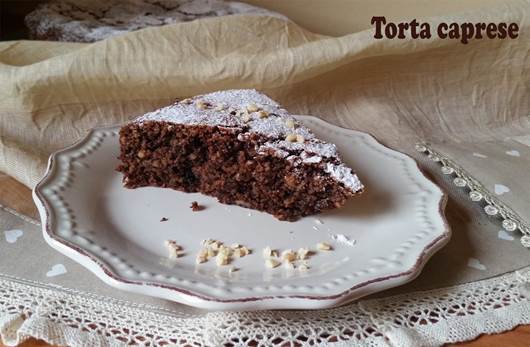
Preface
Traveling is wonderful and food canbe one of the best experiences in a trip. Everybody loves a breathtakinglandscape or a fantastic monument, but it is through food, its culture andtradition, that we really get in touch with a people. Food can be a trip in atrip with quests to find an authentic traditional restaurant, a characteristicdish, to learn the legends and true stories behind the ingredients and thepreparation.
When traveling in Italy these questscan really turn a trip into an unforgettable epic voyage. Each of the 20regions offers its own specialties and typical dishes. If you ask an Italianwhat the national dish is, maybe with the exception of Pizza, he or she willhave a really hard time answering that question. The reason is simple: thereare so many different typical and traditional dishes that no one can fullyrepresent this wonderful variety! Italian cooking varies immensely from Northto South and from West to East of the country. Moreover, you can findvariations of the same dish in small villages just a few miles apart and inlarger cities the families immigrated from the countryside bringing along theirown recipes. Of course every Italian is convinced that her way (or his momsway!) of cooking any dish is the one and only that is correct, and all othervariations are just bland imitations or sad mistakes!
All this can be confusing and a bitdisconcerting for tourists coming to Italy. This is why we decided to writethis concise guide to the gastronomical side of Italy. What you are readingis not an Italian food encyclopedia (which would consist of thousands and thousandsof pages!), but rather a list of the most famous delicacies, a checklist ofthe dishes you really, really have to try when you are in Italy and a record ofthose you should steer well clear of.
This guide also contains a brieftour of all 20 Italian regions that will present a short summary of theirlandscape and points of interest before diving deeper in their foodspecialties. Furthermore you can find some typical recipes, so no one will beable to fool you and when you are back home you can cook your favoritesyourself.
At the same time, we want to let youtake a peek into Italian habits so that you know what to expect and how tointerpret peoples actions and reactions and enjoy your stay in Italy to thefullest. At the end of this guide you can find a vocabulary of indispensablefood terms, something to keep handy while you are ordering your meal in a Ristorante,Osteria, Trattoria, Bar, Tavola Calda, TavolaFredda, Pizzeria, Focacceria
Get in touch
You havent found the answer to your question in thisguide? You can interact with the authors and get credit for pointing outsomething we had not thought about by sending us a message on our Facebook pageand wewill swiftly reply to you!
SUMMARY
PART I
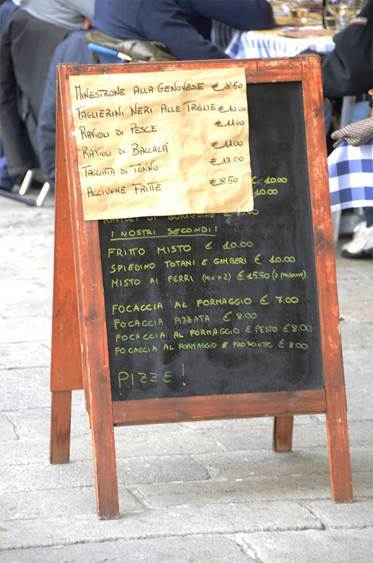
CHAPTER 1) Introduction
1.1) A typical Italian meal
According to tradition, a properItalian meal should comprise an appetizer (cold cuts, pickled vegetables), afirst course (soup, pasta or rice), a main (meat or fish), a side dish(vegetables or salad), cheese, fresh fruit, dessert, coffee and ammazzacaff.That is why most restaurant menus are still divided into these categories.More on that will be discusses in chapter 2: How to read a menu.
Such a meal used to be the typicalfamily Sunday lunch, and even if some families still keep this tradition up, itis certainly not a daily occurrence in a fitness-oriented era. Nowadays no onewould be able to eat so much every day, much less twice a day, for lunch anddinner. Most of us Italian are quite health conscious when it comes to food,both in terms of quality and quantity. Only in special occasions, such asChristmas, New Years Eve, Easter, a birthday or some other celebration, westill indulge ourselves in these epic old-style meals. Another sign ofchanging habits is the growing popularity of Sunday brunches, especially in thelarger cities. Italian brunches are, more often than not, an interesting mix oftraditional dishes and US/UK influence, with pasta and risotto offeredalongside pancakes and scrambled eggs.
Quite a lot of you, at this point,are still wondering what an Ammazzacaff (coffee killer) is!Coffee killer is, obviously, only the literary translation of this term, usedto describe a strong liquor that, drank after a proper Espresso, properly marksthe end of the meal. We Italians believe (or maybe just tell ourselves) that abit of alcohol helps the digestion. Thus a large meal usually ends with a shotof Amaro (a bittersweet herb liquor), Limoncello (lemon liquor), Sambuca(elderberry liquor)or Grappa (a very traditional liquor made from marc). We Italian arequite proud of our liquors, which are very traditional and rather regional soasking one of us which is the best will result in very different answersdepending on the age and the origin of the person being asked.
1.2) How, what and when doItalians eat?
Food wise, a typical Italian daystarts with the Prima Colazione (breakfast, pr:pree-makolatz-ee-on-eh),followed a few hours later by the Pranzo (lunch, pr: prantzo) and finally the Cena (dinner, pr: tchena). With the advent ofglobalization, we also learned of the joys of happy hour (in Italian is Aperitivo,pr: uper-ee'tee-vo ), during which drinks are accompaniedby a significant number of appetizers, ranging from chips to elaborate dishes.Happy hours can be substantial enough to substitute dinner (especially foryoung people on a budget, they can be a great alternative to eating out in arestaurant).
Our breakfast is very different fromthat of most English speaking and northern countries. It is very light andrather sweet. We Italians are very partial to coffee, that in the morning weusually drink with milk (Caffelatte, pr: kaffeh-latteh), eventhough some of us prefer tea or a fruit juice. Food wise, we usually only eat aslice of cake (preferably home-made), some cookies or a slice of bread withbutter and jam. When we have breakfast at a Bar (in Italy its acoffee-house, not a pub!) we usually get a proper Cappuccino and acroissant. We do know that it is rude to stare, but mot Italians will notresist throwing a second glance, with a mix of bewilderment and incredulity, atforeigners eating cold cuts or baked beans for breakfast.
Next page
